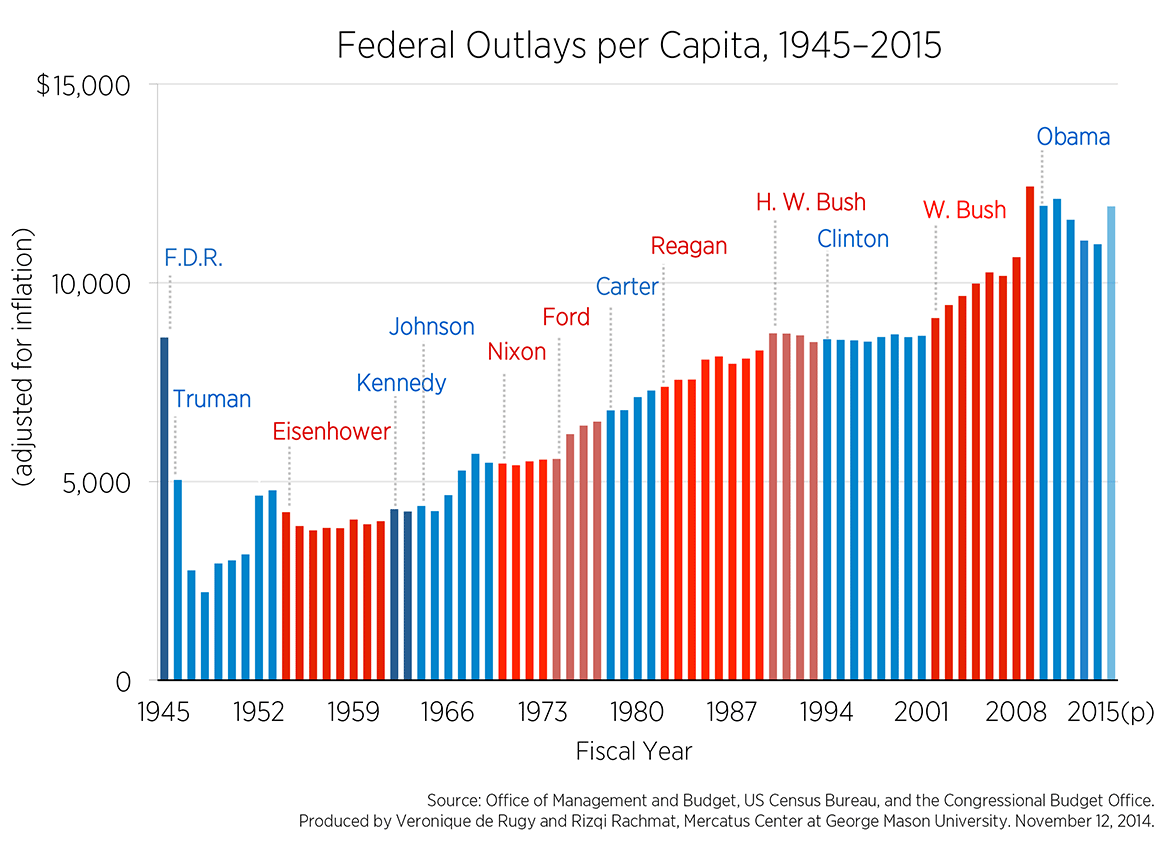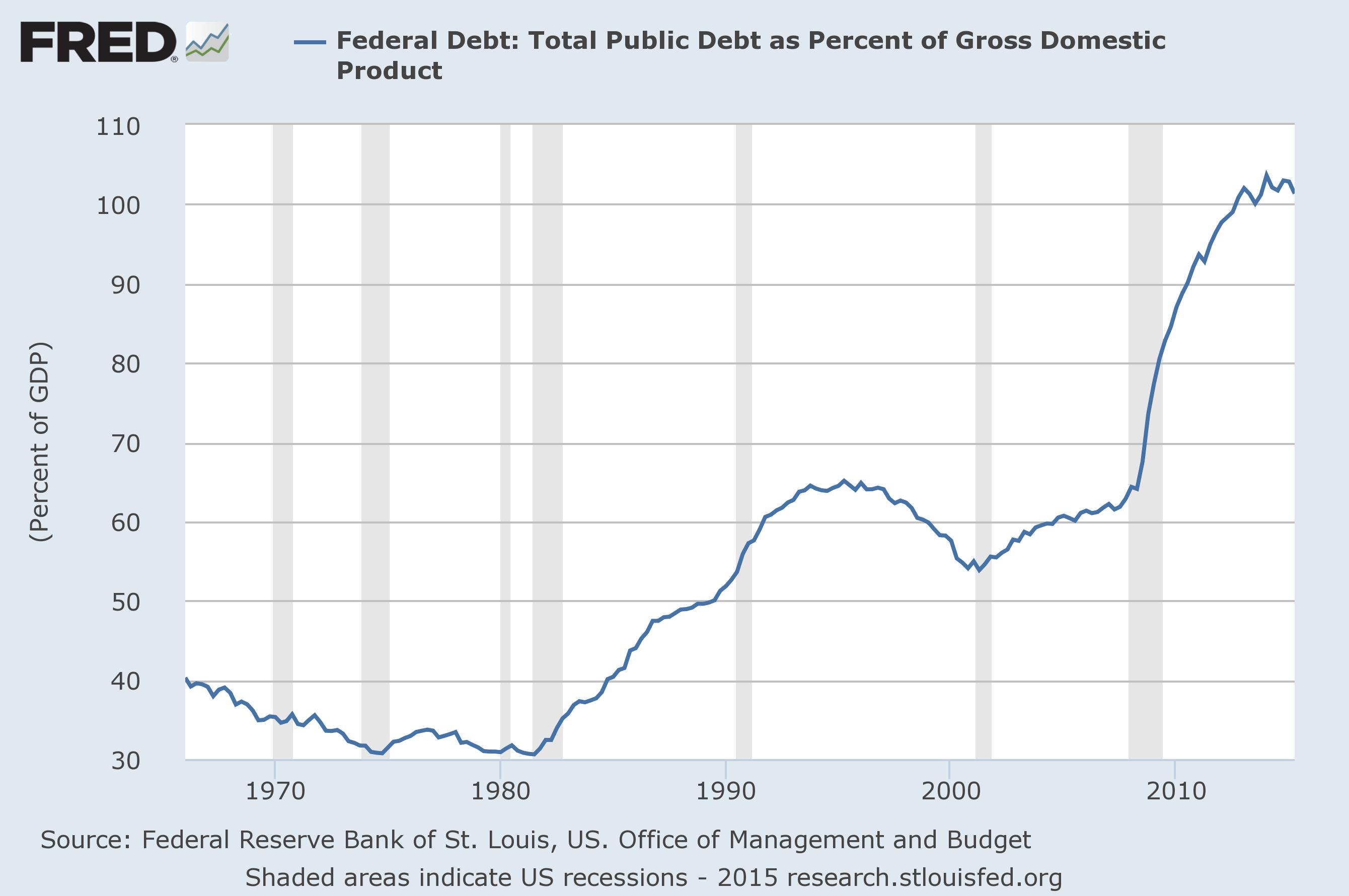The other day, Kevin Williamson posted this about balancing the Federal Budget. It is the typical snarling, snide polemic he is known for recently. Maybe he accidentally drank out of his ink bottle or took a blow to the head, but his work has been of this type for a while. This recent piece is mostly another deranged rant about Donald Trump. The bulk of his column is crap, but this got my attention.
At the moment, our national fiscal situation is considerably less bad than it was during the Obama-Pelosi-Reid era of one-party Democratic rule; the 2010 and 2011 federal deficits were 8.7 and 8.5 percent of GDP, respectively, but the 2014 deficit was only 2.8 percent of GDP. Federal spending went from 24.4 percent of GDP in 2009 to 20.3 percent in 2014, thanks in no small part to budget sequestration, the one national policy in which Washington’s Democrats and Washington’s Republicans are united in loathing. The 2017 deficit is projected to be 2.3 percent of GDP.
That puts us within striking distance of having a balanced budget (albeit one that is balanced at a spending point that is too high for my own taste) or at least the reduction of budget deficits to trivial levels. All that is needed to get there is a little sober reform on the taxing front and a little sober reform on the spending front, with the hardest piece being reform of our entitlement programs, which in the long run will be the major drivers of deficits. I like the idea of radical tax reform, scrapping the tax code, abolishing the IRS, and starting over, and then privatizing Social Security and abolishing Medicare and Medicaid to boot. But you don’t actually have to do that to balance the budget.
That struck me as implausible so I did some mathing. The first thing we need to know is how much debt the Feds are piling on each year. In fact, that’s probably the only thing worth knowing as that is the tax on the future we may or may not be able to sustain. Greece stopped being a country, after all, because it could not service its debt, not because it spent too much or taxed too little. When you can no longer service your debt, you’re done as a country.
According to the Treasury, the amount of total debt held by the public has gone up 23.9% since the heroic budget deal Williamson is fond of touting. That’s better than the previous four years when debt rose by 37%, but there was also the big giant recession where tax receipts dropped. On the other hand, it is still well above the average over the last 35 years, so no one should be celebrating this modest reduction.
The larger point he is making is that with some small tweaks, the federal budget can be balanced. Well, over the last 35 years the annual increase in Federal debt has been 8.3%. In 1980 the debt was $907,701,000,000 and it is now $17,824,071,380,733, as of the end of the 2014 fiscal year. That’s a staggering amount of debt that happened during the two biggest economic booms in the nation’s history. Put another way, in the best of times we have run up debt at record levels.
For another way to look at it, here is the inflation adjusted debt since the 60’s:
There’s no way a sober person can look at the number and come away thinking we are a few tweaks away from solving the debt problem. If that were true, the graph above would not exist. Instead the line would bounce along in that 30% range as it had for so long. Something changed in the 1980’s and as a result debt as been on a steady run upward ever since, regardless of the party in charge and the amount of tweaking.
That raises another interesting question. If debt as a percentage of GDP is spiraling upward and neither party seems to have a way to stop it, what is driving the debt spiral? The most obvious place to look is the spending side as taxes have not changed a whole bunch in my lifetime. They lower rates, but remove deductions. Then they raise rates, but add back in a bunch of deductions. As Reason Magazine noted a few years ago, tax collection remains fairly constant over time.
Here’s one of my favorite charts. It is the per capita inflation adjusted spending. Using 1980 as the starting point, the size of the Federal government has doubled, even adjusting for inflation.

When you look at per capita, inflation adjusted GDP growth, you see something curious. The average growth rate has been 1.86% since 1980, which is interesting for a number of reasons, but what’s relevant here is that it explains the chart above. The cost, per capita, of government may have doubled in 35 years, but so has per capita, inflation adjusted GDP. The cost of the Federal government has simply kept pace with rise of incomes. The relative cost of government has not changed much.
So, what is driving the debt spiral?
The answer is the the debt spiral is self-perpetuating in a zero interest rate world. Imagine you have a personal income of $100,000 per year after taxes and expenses of $105,000 per year. You borrow $5,000 to cover the deficit. Every year your earnings go up 5%, but your expenses go up 5% as well. In 20 years, that annual deficit is $12,500, which sounds pretty good. Your annual deficit percentage has not changed, but your total debt is now $165,000!
Of course, it gets much worse because debt has interest. Even the government pays something in interest today. Using the above example and the historic norm of 7%, the total debt would balloon to over $200,000 in that 20 years and the debt payments would eat up a big chunk of the budget. Long before you got the 100% debt range, your little country would have been forced to cut back and pay down debt.
What’s happened in the free money era since the 1980’s is the cost of borrowing, in the view of politicians, has disappeared. In the age of market based borrowing rates, the bond markets forced the government to choose between competing options. Do you spend more on defense or more on roads? Do you make pension promises for ten years out or does the impact on borrowing make that untenable, because it cuts into current spending on other constituents?
That has not been the case for a generation. Instead of choosing between competing interests, pols just borrow to pacify both interests. The Republicans borrow to cut taxes for their patrons and the Democrats borrow to give goodies to their patrons. Elections, therefore, have no consequences as the parties never threaten each others interest. The voters are simply deciding who gets to spend time at the debt trough.
Of course, there’s a limit to how much debt a government can run up even in a zero interest world. If central banks begin to let rates rise, then the day of reckoning comes much sooner, which is why they can never let rates rise, at least not on purpose. That returns me to the original topic. The only “tweak” that can fix the debt problem is actually a radical change and that comes but one way.


If you thought the banksters are insane now, this will really bake your noodle. Moar! quantintave easing, and deposit the fiat fun bucks resulting directly in middle and low income bank accounts.:
http://www.zerohedge.com/news/2015-10-04/here-come-money-helicopters
What Must Be Done
[Lecture given at “The Bankruptcy of American Politics” conference, sponsored by the Mises Institute and held in Newport Beach, California; January 24–25, 1997.]
https://www.dropbox.com/s/8niknmjnjoh4fu7/What%20Must%20Be%20Done-2.pdf?dl=0
Williamson is impersonating a rational human. He lost me when he wrote that putrid rant stigmatizing southern white trailer trash a couple years ago. It was thoroughly deplorable piece of true bigotry dressed up as pinky in the air ruling class charity. The lyin’ bastard wrote it as if he traveled through those hollows and ridges in Appalachia like he was telling a story from being in a foreign country while in the peace corps himself. I know, I live in those hollows and ridges. I could see where he lied outright about the people and culture. If you didn’t… Read more »
I believe most people have some real understanding of how all this works out. Like the household that is completely financially overextended, it becomes a game of “grab what you can, while you can”, and hope that divine intervention, dumb luck, or what have you will bail us all out. Hence the union games, the pension games, the hedge fund games, etc, etc. All various ways to pick the carcass clean before the comeuppance.
3 options:
1) rates go up. everybody goes bankrupt. economy collapses.
2) rates stay at zero. everybody stops rolling over debt. economy collapses.
3) rates go negative. economy in uncharted territory.
3 is the only option left to try. which is why they’re floating the idea of outlawing cash.
The only real questions left are how negative and for how long. We’re near the point where they may just ban keeping pocket change as that’s the only way to reach the velocity levels they need to keep the plates spinning.
The insanity of it all is they will never relinquish an iota of power to meddle. If anything, they will behave and act in ever more desperation as power to control dissipates in direct relation to their desperation to maintain the illusion of legitimacy. It seems like power which is being employed ever more towards greater centralization, at an ever increasing, increasing rate. I always loved this definition of the old Soviet Nomenklaturer, “An administrative corporate underclass of the ruling elite, which controlled every facet in the sphere of the lives of the people”. Makes sense to me as the… Read more »
I think that what happened, Z, is that in the 70s we abandoned any pretense of a specie-backed currency and moved to fiat money. It took the banksters and politicos about a decade to figure out to game the new system. I’m not a knee jerk anti-fiat money kind of guy. It has some good qualities and bad qualities. But responsible bankers and legislators (I know… that’s like believing in unicorns and leprechauns) really haven’t figured out how to regulate it yet. Of course, that leads us right to what I think is your central theme: what is conservatism and… Read more »
And so what happens when interest rates eventually go up, which they will? Of course, we don’t know when this will happen, but history says that rates have been so low for so long that they must rise soon. The State has benefited greatly from the low-interest rate financialization of the economy, but no tree grows to the sky. It will be obvious to everyone, when rates rise high enough, that the debt is not serviceable, nor will it be repayable. That’s when things get interesting.
Niall Ferguson’s speech and presentation on Fiscal Crises and Imperial Collapses
at http://www.iie.com/events/event_detail.cfm?EventID=152
The powerpoint is quite good if you don’t have time for the video or dislike an historian speaking like Sean Connery.
Same speech, different venue at
http://library.fora.tv/2010/07/28/Niall_Ferguson_Empires_on_the_Edge_of_Chaos
I find the arithmetic compelling even granting that there is no way to foresee the trigger or time the trade.
[…] Now continue reading this, with graphs, HERE. […]